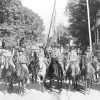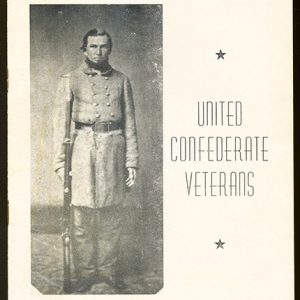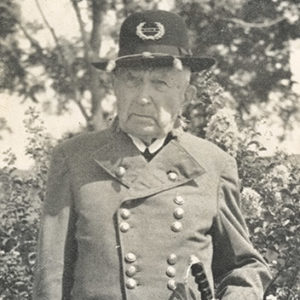calsfoundation@cals.org
United Confederate Veterans Reunion of 1949
The fifty-ninth annual national reunion of the United Confederate Veterans (UCV) marked the third and final time that Little Rock (Pulaski County) served as host city for the event. Thereafter, the UCV held only two more national reunions.
The Sons of Confederate Veterans (SCV) planned and organized all of the event’s activities. Little Rock’s Robert C. Newton Camp of the SCV served as the host organization throughout the reunion. Other organizations associated with the reunion included the Order of the Stars and Bars and the Confederated Southern Memorial Association (CSMA).
Due to the limited number of living Civil War veterans, reunion officials expected no more than eight veterans to attend the event. Even this modest attendance expectation went unfulfilled, however, as only four veterans made the journey. Their average age was reported as 100.5 years. The limited number of surviving veterans reflects the smaller number of committees and activities compared with earlier, more heavily attended reunions.
The reunion took place on September 27–29, 1949, during which time Governor Sidney McMath declared “Confederate Week” and called for a general commemoration with public displays of the Confederate flag throughout the city. As with the reunions of 1911 and 1928, the Marion Hotel served as reunion headquarters.
As part of the opening ceremonies on Tuesday, September 27, the attending associations conducted a joint session with short speeches by Gov. McMath; Little Rock mayor Sam W. Wassell; North Little Rock (Pulaski County) mayor Ross L. Lawhon; Carl Olsson, commander of the Robert C. Newton SCV Camp; a representative of the United Daughters of the Confederacy; national UCV commander James W. Moore; and dignitaries from various other related organizations. This session concluded with a benediction. The first night’s menu consisted of an old-fashioned southern dinner with invocation by the Reverend Albert Sidney Johnson, the SCV chaplain-in-chief from Charlotte, North Carolina. Entertainment included two musical concerts; the first was held early in the day on a bandstand erected at the War Memorial Building (now the Old State House), while later in the evening the U.S. Marine Corps band performed at the Robinson Memorial Auditorium.
On Wednesday, September 28, members conducted business sessions that included the selection of a reunion site and election of national officers for 1950. The veterans unanimously elected Moore as permanent and final UCV national commander. Moore held this title until his death on March 26, 1951. They selected Biloxi, Mississippi, to host the sixtieth national UCV reunion in 1950. This session also concluded with a benediction by Rev. Johnson. The marine band then performed a concert at the War Memorial Building.
At noon, the CSMA conducted a memorial service, open to all participants, followed by a “Confederate Tea” sponsored by the Woman’s City Club and the United Daughters of the Confederacy. In the evening, the Marine band performed another concert at the War Memorial Building, followed by a Confederate ball with flag drill and a grand march at the Robinson Memorial Auditorium.
The grand marshal, Colonel Lee V. Casey of the Arkansas National Guard and commander of Little Rock’s M. M. Eberts Post No. 1 of the American Legion, led the closing ceremonies on Thursday, September 29, with a Confederate parade that got underway at the Marion Hotel at 10:00 a.m. As usual, the veterans rode in open-topped automobiles. The route began at 10th and Main streets, preceded north on Main Street to Markham Street, and then turned west onto Broadway. The reviewing stand was located at the War Memorial Building.
Of the four veterans in attendance, at least one has been subsequently identified as an imposter. Historian William Marvel’s research has definitively demonstrated that Thomas E. Riddle of Wichita Falls, Texas, who claimed to be 103 years old with a birth year of 1846, was actually born in 1862 and, thus, was no more than three years old when the war ended in 1865.
No service records exist to verify the claims of 100-year-old W. W. Alexander from Rock Hill, South Carolina, or ninety-seven-year-old James A. Thrasher of Louin, Mississippi. If his reported age is accurate, Alexander would have turned sixteen in 1865, so his claim of military service remains more plausible than Thrasher’s claim. At ninety-seven years of age in the fall of 1949, a likely birth year of 1852 means Thrasher was only thirteen in the war’s final year. The fact that Thrasher resided at the Confederate Veterans Home in Beauvoir, Mississippi, from 1949 until three months before his death in 1951 does not confirm his service claim, as such facilities routinely did a poor job of verification.
A service record does confirm ninety-eight-year-old UCV national commander James William Moore’s claim that he enlisted with his father and served as an underage mascot with Company I of Colonel John T. Morgan’s Fifty-first Alabama Partisan Rangers, which served under Major General Joseph Wheeler in the Army of Tennessee. A longtime resident of Selma, Alabama, Moore graduated from the Virginia Military Institute in the class of 1873 and, along with the entire corps of cadets, attended Robert E. Lee’s funeral in October 1870.
In spite of its necessarily limited attendance, the 1949 UCV reunion earned wide acclaim as a successful tribute to an ever-shrinking population of Confederate veterans. Norfolk, Virginia, hosted the final national UCV reunion in 1951.
For additional information:
Civil War Reunion Collection. Old State House Museum Online Collections. Reunion Collection (accessed December 7, 2020).
Fifty-ninth Annual Reunion United Confederate Veterans, September 27, 28, 29, 1949, Little Rock, Arkansas. Little Rock: United Confederate Veterans, 1949.
Hanley, Ray, and Steven G. Hanley. Remembering Arkansas Confederates and the 1911 Little Rock Veterans Reunion. Charleston, SC: Arcadia Publishing, 2006.
“Historical Rosters Database.” VMI Archives Digital Collections. Virginia Military Institute. http://archivesweb.vmi.edu/rosters/record.php?ID=1576 (accessed December 7, 2020).
Ralston, Clark. “Cause Not Lost, Officer of SCV Assures Aged Veterans.” Arkansas Gazette, September 28, 1949, pp. 1A, 6A.
———. “Throngs Cheer, Bands Play ‘Dixie’ As Old ‘Rebs’ Bow Out.” Arkansas Gazette, September 30, 1949, p. 3A.
Towns, W. Stuart. Arkansas Civil War Heritage: A Legacy of Honor. Charleston, SC: History Press, 2013.
William Marvel. “The Great Imposters.” Blue and Gray 8 (February 1991): 32–33.
Robert Patrick Bender
Eastern New Mexico University–Roswell
 Civil War Veterans' Reunions
Civil War Veterans' Reunions Early Twentieth Century, 1901 through 1940
Early Twentieth Century, 1901 through 1940 1949 UCV Reunion Program
1949 UCV Reunion Program  ACWSC Logo
ACWSC Logo  James W. Moore
James W. Moore 




Thomas Evans Riddle was telling the truth. The 1862-born Riddle was a different man. Terry D. Lowry’s history of the 22nd Virginia lists him where he said he was, providing his claimed birthdate as well. He is also mentioned by name in a February 1863 entry in the diary of another member of the regiment, John B. Sheets. Response from Dr. Robert Patrick Bender, entry author: Mr. Riddles date of birth and military service are much more debatable than the commenter suggests. At various times Riddle claimed enlistment in the 12th Tennessee, 22nd Virginia, and 33rd Virginia (and that his mother was supposedly related to Robert E. Lee). He never produced any legitimate form of documentation to substantiate any of his claims (and the claims seemed to change with every interview). The name Thomas Riddle is listed on the NPS Civil War Soldiers and Sailors site, but it lists the same individual variously as Thomas E. and Thomas C. (making it anyones guess as to whether that individual is the Thomas Riddle in question). Many volumes in the Virginia Regimental Series, including Lowrys, are available as searchable Google Books, but I find no reference to a Thomas Riddle in the volumes for the 22nd or 33rd Virginia. William Marvels 1991 investigation of this issue was very thorough and published a couple years after the regimental histories. As for the 1862 date and the comment that it was for a different man, I do not know on what source the commenter based that statement. Much of Riddles story has been posted and reposted on Internet discussion boards, but such references merely repeat portions of Riddles various undocumented claims. There are simply too many holes and inconsistencies in Riddles story for it to be verified.